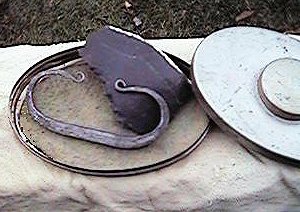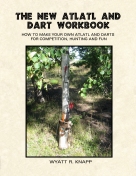FLINT AND STEEL FIREMAKING
There's no doubt that the ability to make and control fire was one of the greatest technological advancements of mankind after tool making. It was there for warmth, protection, cooking, hunting and even primitive agricultural techniques. The knowledge of how to make fire utilizing primitive methods directly connects us to the people who used these techniques. When you are coaxing fire from some tinder using a coal that you created, and you see the glow get brighter, and you smell that curl of smoke, and the tinder suddenly bursts into flame, you are experiencing exactly what the ancient ones did so very long ago.
Sparks From Flint
It is the old one. The constant metaphor for great beginnings. The spark.
Long ago the ability to create and make use of hot sparks to make fire was discovered. We can recreate these methods easily today with just a little practice.


Top: A fire works kit consisting of a striker and a piece of good black flint is shown in its waterproof tinder box. The box has an integral magnifying glass for concentrating the sun's light onto tinder when the clouds aren't around. (I have heard of people making lenses out of ice and starting their fires with them.) Bottom: Proper hold for the striker and flint when striking sparks. Normally a piece of charcloth would be held near the top edge of the flint by the thumb of the left hand.
Before the introduction of steel, sparks were obtained using a piece of iron pyrite for the striker. It was smacked across the edge of a piece of flint to make sparks which were caught in tinder. Later, steel strikers were employed and used in the same manner. You hold a large piece of flint, with the sharp edge out, in one hand. You then keep a piece of charred tinder in place on top of the flint with your thumb. The flint is then struck a sharp blow with the steel and the resulting sparks are caught in the tinder and then blown on to ignite a nest of dry grass, or other such material, into flame. Be very careful to keep your knuckles away from the sharp edge of that flint or you'll get cut. A material is required that will be very effective in catching sparks and just such a material is next to be discussed.
How To Catch A Spark
One of the best materials for catching a spark is charcloth. It has been used for centuries. I like to make my charcloth from old cotton bluejeans. Take an old, empty, one quart paint can and throw it in a fire and let it sit until anything that might have adhered to the sides is burned off. After it cools, take a common size nail and punch a venthole in the lid of the can. What you have now is a container that can be used over and over to make charcloth. Take the pure cotton material and cut it into pieces that are about 4" by 4" in size. Place them loosely into the can and pound the lid on. Throw the can into the fire so that the vent hole isn't blocked. You'll see smoke pour out of the vent hole and sometimes this stuff coming out catches and makes a flame. Don't let the cloth get overcooked or it will be scorched and crumbly and useless. A wire or coat hanger can be placed around the can to help to get it out when it's done. Don't open the can yet. Let it cool first or it may ignite. The cloth has been charred in the absence of enough air so introduction of it at this time would be a bummer. If you look at the cloth and it doesn't seem done, then put it back in the can, seal things up, and throw it in the fire again for a bit till it's right. When you need to use some charcloth, just tear a piece off. Keep your charcloth in a dry container or ziplock bag.
You can do the same thing with the dry, punky wood you find in old stumps. Just take some pieces of it and char it in the can like you did for the cloth.
There is a fungus called innonotus obliquus that grows on Birch trees that can catch a spark without being charred. I use it a lot and it's great stuff. The American Indians in my area of the United States are said to have called it "chaga".
This page was last updated on 16 March 2012.
Copyright © 1998 & 2012 by Wyatt R. Knapp
History & Primitive Technology Page
Flintknapping: Observations & hints, hafting glue, etc.
Buckskinning Skills: Making gunflints, ancient Firemaking techniques, etc.
Primitive and Traditional Skills Links.
"The New Atlatl and Dart Workbook" by Wyatt R. Knapp! Click for more information!
Learn about the atlatl and dart system & the physics behind this powerful weapon
The Mysterious Nazca Lines: How were these huge desert glyphs made? Ancient astronauts?
Victory! Outdoorsmen, primitive skills enthusiasts! Find out more here!

